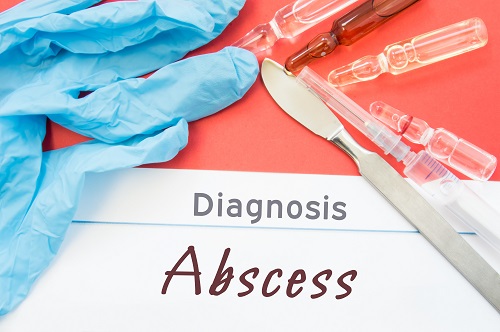A skin abscess is like a lump surrounded by a pink or dark red area. It is often developed in the skin and can be easily identified just by touching. It is necessary to keep a check with it to find out the exact cause and get rid of it. An abscess is full of puss and very warm. They are, however, very unhygienic and contain a lot of dirt, debris, and bacteria.[1]
Since it is a skin condition, it can develop in any part of the body. However, mostly abscess occurs around armpits, areas close to vagina and anus, tooth, groin, and even the base of the spine. Sometimes the hair follicles may get swelled up, thereby leading to the development of boil.[2]

What is an abscess?
An abscess is also known as boil and is a skin condition due to which bumps start appearing on the skin surface. It is a translucent fluid, which is usually a result of bacterial infection. Skin abscess can appear around any body part. Often these skin abscesses are not harmful and can quickly go away. But sometimes over the counter medicines and medicines are required to get rid of these.[3]
Minor abscesses are generally painless and may not cause that much harm. However, it is necessary to get these treated only in the initial stages, or they might get dangerous. If the condition becomes serious, it will be in severe need of drainage and laceration.
Common causes of skin abscess
The breakage of the skin surface allows entry to bacteria. The abscesses usually form as the body’s response to fight against these bacterias and germs. Moreover, damages around the sebaceous gland or pre-existing cysts can also lead to an abscess.[4]
People with weak immune systems are more prone to being infected by an abscess. Here’s a list of common causes of skin abscess
Bacteria
Staphylococcus is the most common bacteria leading to abscesses. The skin abscesses occur when the bacteria enter the body through a wound or injury that led to the rupture of the skin surface.
You are at an increased risk of bacterial infection under the following conditions.
- Came in close contact with someone who is already infected with staphylococcus bacteria
- Chronic conditions like eczema and acne
- Diabetes
- Weak immune system
- Unhygienic habits
Infected hair follicles
Infected hair follicles give way to abscess around the follicles. Follicular ulcers occur when the follicles become trapped under the skin, and it becomes tough to remove them. Trapped hair follicles are referred to as ingrown hair, which can cause a lot of infection.[5]
Abscesses caused due to the infected hair follicles will always contain the ingrown hair. Furthermore, being in the chlorinated pool or hot tub for too long can also lead to an abscess.[6]
Who is more at the risk of developing abscess?
Not everyone’s immune system is strong enough to get rid of the infections.[7] Some of the most common conditions that make a person prone to developing skin abscess include the following:
- Sickle cell disease
- Chronic steroid therapy
- AIDS
- Cancer
- Severe burns and trauma
- Ulcerative colitis
- Chemotherapy
- Obesity
- Crohn’s disease
- Alcoholism
Skin abscess symptoms
An abscess is often confused with being a pimple due to its appearance. But if it’s not taken care of in the initial stages, it will grow out to become full of puss and appear like a cyst. The symptoms usually vary depending on the cause of the abscess. Some of the common symptoms of an abscess include the following
- Fever
- Nausea
- Chills
- Inflamed skin
- Lesions on skin
- Fluid drainage from the abscess
The symptoms will keep getting worse if not treated initially. It might affect the bloodstream as well.[8]
Complications related to skin abscess
An abscess can cause some serious health concerns, so it is necessary to keep a check with them. Some of the serious complications caused due to abscess include the following
- Blood poisoning or sepsis
- The rapid spread of infection affecting the spinal cord and brain
- Death of tissues around abscess infected areas
- Acute bone infection
Methicillin-resistant Staphylococcus aureus is one of the potential complications caused due to skin abscess. There are different antibiotics for treating the condition, but they might not work accordingly.[9]
How to treat skin abscess
An abscess can be treated at home (if it’s minor) and through drainage and antibiotics (if the condition is serious).[10]
Home Treatment
Heat is known to reduce the size of the abscess. So, you can apply some heat to shrink the size and eventually drain it. A warm compress can be a potential treatment for getting rid of the abscess.
Drainage
Home healing methods may not always work to cure an abscess. In such situations, you should prefer seeing your doctor, as they can follow the drainage procedure more effectively.[11]
The doctor will usually cut the abscess to allow drainage and some numbing medications to avoid pain. Once the drainage is complete, the doctor will follow surgical methods to seal it to prevent the abscess from reoccurring and allow faster healing.
Antibiotics
Drainage isn’t always compulsory for skin abscess, and it can be treated easily with antibiotics. The doctor may give antibiotics like dicloxacillin or cephalexin to treat the conditions.[12]
A higher dosage of antibiotics will be offered only if the skin abscess transforms itself into MRSA. If you complete the dose of antibiotics, the abscesses won’t return.
How to prevent skin abscess
Prevention of skin abscess may always not be possible, but some conditions can prevent staphylococcus infection from growing. Some of the common ways to minimize the risk of developing the disease include the following
- Wash your hands
- Maintain hygienic habits
- Bandage the cuts and wounds
- Avoid sharing personal items such as razors, sheets, and towels
Abscesses go away easily only if they are taken care of. Make sure to seek medical attention as soon as you can to avoid any unnecessary circumstan
[1] https://pubmed.ncbi.nlm.nih.gov/29614180/
[2] https://www.ncbi.nlm.nih.gov/pmc/articles/PMC3582519/
[3] Hammond SP, Baden LR. Management of skin and soft-tissue infection—polling results. New Engl J Med. 2008;359:e20. [PubMed] [Google Scholar]
[4] Edino ST, Ihezue CH, Obekpaa PO. Outcome of primary closure of incised acute soft-tissue abscesses. Niger Postgrad Med J. 2001;8:32–36. [PubMed] [Google Scholar]
[5] https://www.ncbi.nlm.nih.gov/pmc/articles/PMC2231432/
[6] Meislin HW, McGehee MD, Rosen P. Management and microbiology of cutaneous abscesses. JACEP. 1978;7(5):186–91. [PubMed] [Google Scholar]
[7] https://www.ncbi.nlm.nih.gov/pmc/articles/PMC4851110/
[8] https://www.ncbi.nlm.nih.gov/pmc/articles/PMC6451992/
[9] Halvorson GD, Halvorson JE, Iserson KV. Abscess incision and drainage in the emergency department—part I. J Emerg Med. 1985;3(3):227–32. [PubMed] [Google Scholar]
[10] https://www.ncbi.nlm.nih.gov/pmc/articles/PMC4100857/
[11] Llera JL, Levy RC. Treatment of cutaneous abscess: a double-blind clinical study. Ann Emerg Med. 1985;14(1):15–9. [PubMed] [Google Scholar]
[12] Edino ST, Ihezue CH, Obekpa PO. Outcome of primary closure of incised acute soft-tissue abscesses. Niger Postgrad Med J. 2001;8(1):32–6. [PubMed] [Google Scholar]

